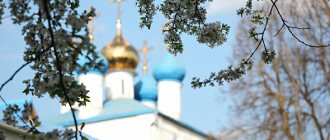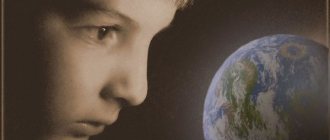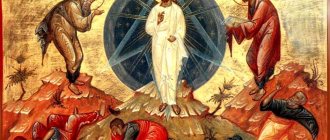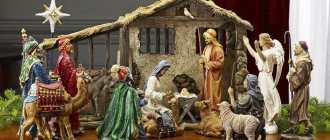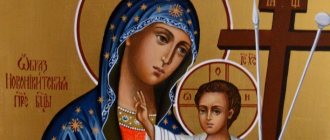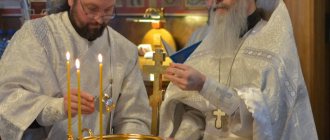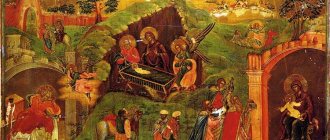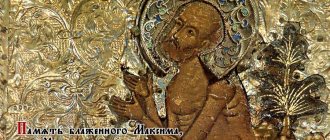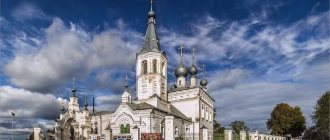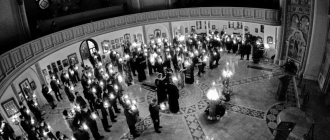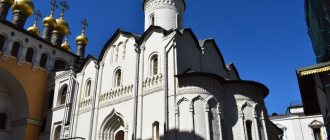We know about the Nativity of the Savior and the events related to it from the evangelists Matthew and Luke, and they, probably, from the words of the Most Holy Theotokos. The stories of the apostles are different, but surprisingly complement each other.
Matthew speaks not so much about Christmas as about the events before and after it: how an Angel dispelled the embarrassment of Joseph the Betrothed, who learned about the pregnancy of the Virgin Mary; how the Magi came to worship the born Baby. Luke begins with the appearance of an Angel to the Virgin Mary herself: “You have found grace from God,” the Angel announced to Her, “and behold, you will conceive in your womb and give birth to a Son, and you will call His name Jesus.” He will be great and will be called the Son of the Most High... and His kingdom will have no end (Luke 1:30-33). Next, Evangelist Luke describes the circumstances of Christmas: ...a command came from Caesar Augustus to take a census throughout the whole earth... And everyone went to be registered, each to his own city. Joseph also went from Galilee... to the city of David, called Bethlehem... to enroll with Mary, his betrothed wife, who was with child. While they were there, the time came for Her to give birth; and she gave birth to her firstborn Son, and wrapped Him in swaddling clothes, and laid Him in a manger, because there was no room for them in the inn (Luke 2:1-7).
Dislocation of the heart
A dislocation is a very painful injury. You can try to relieve the pain with pills, or with some ointments. Maybe this will bring some relief, but not for long - while the joint is dislocated, the person will only get worse. Pain, inflammation, inability to walk normally are only external symptoms; the cause of all this is a dislocated joint. There is little that can be done about the symptoms until you have the sprain reduced.
The terrible, tragic history of mankind, all the troubles and horrors that we hear about, all human misfortunes, from divorces to world wars, are only symptoms of our main problem:
what might be called a “dislocation of the heart.” In European poetry, "heart" is usually associated with emotion; but the Bible is more about the “core,” the center of our personality where we set goals, prioritize, and make decisions that shape our lives. And now our heart is dislocated, just as a joint is dislocated.
The Apostle James describes our common misfortune this way: You desire and do not have; you kill and envy - and cannot achieve; you bicker and fight, and you do not have because you do not ask. You ask and do not receive, because you ask wrongly, but to spend it on your lusts (James 4 :2,3). What we want, what we persistently demand from God and people, what we proclaim as ours by right, is most often not at all what we need. Sometimes from the outside it is obvious: a person suffering from alcoholism wants vodka, but we understand that he does not need vodka, he needs to be cured of his passion. But, as a rule, we do not notice how deeply our heart is dislocated. People - not those whom everyone is ready to recognize as sick, ordinary people, you and me - subordinate their lives to false values that bring nothing but unhappiness, crave for what does not bring the slightest benefit, fight fiercely with each other for what that they don't really need.
Most people, including non-believers, will agree with the Old Testament words: Better is a dish of greens with love in it, than a fat ox with hatred in it (Proverbs 15:17 ). But the same people spend a lot of effort on acquiring “bulls” - money, property, social status, and do not care at all about making their hearts loving. On the contrary, rivalry over “fattened bulls” turns into a reason for hatred and violent conflicts, often even between members of the same family. Great warriors devastate entire continents, ordinary people destroy the lives of their loved ones, and why? For the sake of what the Apostle John defines as the lust of the flesh, the lust of the eyes and the pride of life (1 John 2:16 ): the desire for pleasure, for possessions and for “prestige”. People seek happiness and seek it where only unhappiness can be found. The entire human race is characterized by this tragic fracture, this corruption of the will, which the Church calls sin. It is sin that is the cause of all human misfortunes, and people cannot be saved from them without eliminating this cause.
It seems to people that the world around them must change - circumstances, climate, other people - and then they will be happy. But the Gospel draws attention to the fact that the root of our misfortune is in ourselves.
A former drug addict who turned to Christ wrote a book called Save Me from Myself, which is a very apt title. It is very difficult to admit that we inflict the worst evil on ourselves, and often we need to be saved not from what we consider to be our troubles, but from ourselves - from our own evil and madness, which lies at the root of all these troubles.
Worship of the shepherds. Rembrandt Harmens van Rijn. 1646
FRANCE
Traditionally, most Russians going to France for winter holidays choose Paris . This, of course, is far from the only holiday destination in the country: as an alternative to Paris, tour operators recommend paying attention to Alsace - after all, it is here that the most iconic and most beautiful French Christmas markets are located. The journey from Paris to Strasbourg takes less than two hours by train.
What fairs to visit in France
Strasbourg is the “capital of Christmas” in France. The city has twice (in 2014 and 2015) received the award for the best Christmas market in Europe. The oldest fair in Europe, Christkindelsmärik, is also located here, first opened in 1570. Now the fair consists of 300 stalls located at 12 sites in the city center. Here you can try not only local products, but also listen to live music and attend various cultural events.
Not far from Strasbourg is the small but very beautiful town of Colmar. Over the course of six weeks, the city is bathed in the lights of five local Christmas markets. Each market is actually a mini-village; visitors are offered products from local craftsmen. Most of them are from Alsace and were chosen for the quality and uniqueness of their products.
In Strasbourg, fairs will be open from November 25 to December 31, in Colmar - from November 24 to December 30.
How much does Christmas France cost?
Tour operator ICS Travel Group offers to come to France early and celebrate Christmas with the Parisians. A tour lasting from 4 nights with departures from December 21 to 23 starts from 60,405 rubles for two (2* hotel with breakfast, regular flights with connections, no transfer).
If you want to celebrate the New Year in Paris, ICS Travel Group offers a 7-night tour with a departure on December 26 (direct flight with Air France, 2* on breakfast, transfer included) at a price of 98,430 rubles for 2 people.
Desired by all nations
But when we talk about “dislocation,” we mean that there is a correctly positioned heart, just as there is a normally functioning joint. In almost every human civilization - the Egyptians, Indians, Chinese, anyone else - there was an idea of \u200b\u200ba harmonious moral world order, of which man was a part, an order that determined man's duty in relation to his neighbors and the universe as a whole. This order set objective criteria for what is right and what is wrong; it was he who determined how a person should go through his life path. People might argue and make mistakes about what this order is and what it requires of us, but no one doubted its existence. A full human life - happy, fruitful, worthy - was determined by how consistent a person lived with this world order. “A noble man,” said the Chinese thinker Confucius, “thinks about the righteous path and does not think about food.” And in almost all cultures there was an awareness of the tragic gap, the inadequacy of man to his true destiny. Therefore, the Old Testament prophet speaks about what is desired by all nations (Hag 2 :7) - about the Savior who will restore the destroyed harmony.
Among the peoples of the earth, suffering and languishing in anticipation of salvation, there was one to whom the truth was revealed not in the form of intuitions and rare insights, but with all clarity - this was the people of the Old Testament, Israel.
It was revealed to these people that behind the moral order, which all people are aware of, stands God, the Creator of the world, vague memories of Whom were preserved among different peoples, a God from whom people fell into sin. It was revealed to this people that a rightly placed heart is a heart in right relationship with its Creator. As the first commandment of the Decalogue says, I am the Lord your God, who brought you out of the land of Egypt, out of the house of slavery; Let you have no other gods before Me (Exod. 20:2, 3).
Other gods are not necessarily Baal or Astarte, Wotan or Perun. This is what a person serves, what he puts at the center of his life - money or pleasure, power or honors, ideas or political leaders. As long as the human heart is turned not to God, but to something else, it is severely dislocated and leads a person to temporary and eternal troubles.
Healing the human race—and every individual—must mean restoring our relationship with God. As St. Augustine said, “You created us for Yourself, and our heart knows no rest until it rests in You.”
CZECH
The capital of the Czech Republic is one of the most popular destinations for Russians at Christmas. Prague is transformed and sparkles with thousands of lights, Christmas trees are decorated. Many stores are announcing Christmas sales.
What to buy and try
At the Christmas markets you can try punch, mulled wine and honey, buy such traditional local sweets as honey gingerbread, vanokva (a nine-strand braid with raisins), vanilla bagels and nut nest cookies, Prague ham, roasted chestnuts, trdelnik , fried cheese, hot pancakes, etc.
Christmas markets operate in Prague from December 2 to January 6. Tourists are recommended to come to Christmas Prague in advance - December 20-21 - then there is a greater choice of hotel rooms.
How much does a Christmas tour to the Czech Republic cost?
Tour operator ICS Travel Group offers attractive prices for flights on December 21 - a 7-night tour for 2 people costs from 42,445 rubles (3* on breakfast, flight on a CSA airline, 23 kg luggage included). There are also program options with departure on December 24 for 4 and 7 nights at prices starting from 40,340 rubles (similar vacation options).
Prices go up on New Year's dates. You can celebrate the New Year in Prague through the tour operator ICS Travel Group for a price starting from 64,614 rubles for two (5 days, 3* hotel with breakfast, air flight). By the way, today this airline offers the best fare for these dates, but the offer is limited.
The tour operator "VEDI TOURGROUP" offers several options for celebrating the New Year in the Czech Republic for every taste of tourists. So, for example, you can celebrate the New Year on a boat, go to the U Pavouka tavern or the Detenice estate to celebrate.
You can book these options for celebrating the New Year as part of VEDI TOURGROUP package tours with flights on charter or regular flights.
Law given through Moses
At the Christmas service they read the genealogy of the Savior - a long list of male names, which to modern people seems completely unnecessary and incomprehensible. This fragment of Scripture is by no means accidental: Christ is not an alien, he belongs to His people, and through them to all humanity. For a long time, God prepared for His coming - and this was the era when God revealed the Law to people, the commandments that they had to follow. As the Bible tells us, the initial reaction of the people was full of enthusiasm: whatever the Lord has said, we will do and obey (Exodus 24 :7). But it soon became clear that people did not obey the law, no matter how solemnly they swore to do so. In theory we all agree, but in practice nothing works out for us. People accuse each other of hypocrisy - and in this regard we all live in glass houses, because none of us follows the moral code that we ourselves recognize as fair.
As the Lord Jesus said, Did not Moses give you the law? and none of you walks according to the law (John 7:19 ). Yes, there are people who believe that they already keep the commandments of God; It would be more appropriate for them to imitate the modesty of the man who, when asked if he could play the violin, answered “I don’t know, I haven’t tried.” We can think that we are keeping the commandments only if we have not even tried to keep them; any attempt to seriously live according to the Word of God leads us to the realization that we are failing. And the point is not that the requirements of the law are excessive - our conscience agrees with them, and we ourselves would like other people to behave with us mercifully, humbly and honestly, but when we ourselves try to behave this way, we again and again stumble to some kind of obstacle. As the holy Apostle Paul writes about this, I do not do the good that I want, but the evil that I do not want, I do (Rom 7:19 ). We don't need instructions on how to behave; we need something much more.
Flight into Egypt, Rembrandt Harmens van Rijn, 1625
Traditions of celebrating the Nativity of Christ
In Russia, until 1917, Christmas was considered one of the favorite holidays, and to this day many call it the “Mother of all holidays.”
The main tradition that came to us under Tsar Peter I from Western countries was the decoration of the Christmas tree. There was no family where spruce, pine or, for example, juniper were not removed for the holiday.
The period of waiting for Christmas is called Advent - it is a time of joyful anticipation. Advent consists of four weeks. One candle was lit every Sunday morning for four weeks. It was supposed that the first candle was lit by the youngest child in the family, the second by the eldest, the third by the mother, and the fourth candle by the father.
Lighting candles carried an important meaning, signifying the retreat of darkness, fear and the emergence of hope and expectation. The candle flames lighting up one after another symbolizes that something good is already happening, and even greater joy awaits in the future.
All four Sunday mornings of Advent were accompanied by the light from a new candle and the appearance of some kind of treat on the table. One cannot but agree that it is a good tradition to organize a small holiday for yourself once a week during the coldest time of the year.
An equally amazing tradition associated with Christmas is the ritual of caroling. On Christmas night, children, teenagers, and young people gathered in small groups and went around to all the houses to congratulate the owners on the holiday. This was accompanied by fun, games and majestic chants - carols.
It was considered a good omen if Kolyada came to the house on Christmas night. In gratitude, the owners of the house had to put some kind of treat in the bag of the carolers.
Christmas Eve - Christmas Eve
Christmas Eve is called "Christmas Eve".
On the eve of Christmas, the appearance of prosperity and wealth, peace and tranquility was created in all houses.
Christmas Eve was the last day of strictly Advent fasting. It has always been customary to gather around the festive table with the appearance of the first star in the sky - this is associated with the legend of the Star of Bethlehem, which entered over the ancient city and notified the Magi about the birth of the Savior.
The food, consisting of 12 hearty Lenten dishes - corresponding to the number of the Apostles - could only be started at the rising of the morning star. The main, main dish of Christmas Eve is kutia: boiled rice with honey, raisins, nuts or dried fruits, and freshly baked, homemade bread.
And before sunset, the whole family prayed to the Lord , after which they brought straw into the house and covered the benches and floors with it, so as not to forget where the Son of God, the Savior Jesus Christ, was once born.
It was believed that the richer the housewife’s table, the more carefully she prepared, the better the harvest. On this day we met with our parents and listened to their instructions. The color of Christmas was traditionally considered white - a symbol of purification, purity - therefore they covered a white tablecloth and white napkins. Before the feast, the owner took several small portions from each prepared dish and went to feed his dogs, sheep, horses and cows. Only after this did everyone start eating.
It is noteworthy that everyone believed that deceased relatives shared a festive meal with them. Therefore, the table was not cleared until the morning and the uzvar and kutya were left on the window.
It was great luck if a guest, even a stranger, came to the house - it was believed that he brought happiness with him. He was invited to the table.
It was impossible to quarrel, only harmony and peace were welcomed on this sacred evening. Children were always told stories about the birth of Jesus.
Christmastide
The twelve days following Christmas are called Christmastide - that is, holy days. This period is accompanied by another tradition - Christmas fortune-telling.
But fortune telling on Christmas Eve is one of the surest ways to attract misfortune..
These days the Birth of Christ is glorified and this period is an important church celebration. Fortune telling turns people away from God! It is necessary to understand that “recognizing your betrothed” through secret devilish power is a great, unforgivable sin! Just like fortune telling in general in any form and at any time of the year, it only brings irritation and despondency to the soul - one cannot help but take this into account when deciding to take such a reckless step. Only turning directly to God gives inner peace: we can ask in our prayers for everything we need. And when making requests, we must know for sure that even if things don’t go our way, they will happen as needed for our salvation. But under no circumstances should we try to blindly predict fate by resorting to dark forces, even if we really want to know and change the future!
Grace and truth came through Jesus Christ
People often think that religion is a set of rules; This is largely true of non-Christian religions. Some praise these rules, some criticize them, but both agree that this is precisely a set of rules. In addition to the rules in religion, there are also sacred texts in which these rules are spelled out.
There are rules and texts in Christianity. But the center of Christianity is not here. God's law helps us see our sin and our helplessness, but in itself it does not bring salvation. By the law, writes the Apostle, sin is cognized. He makes a diagnosis - we understand. that we are seriously ill. Therefore, God does something much greater than giving the Law - He gives us Himself.
At Christmas we do not celebrate the sending down of the Law or the giving of sacred texts. We celebrate the appearance of God who came and dwelt among us forever. As the Evangelist John says, In the beginning was the Word, and the Word was with God, and the Word was God. It was in the beginning with God. Everything came into being through Him, and without Him nothing came into being that came into being. In Him was life, and life was the light of men. And the light shines in the darkness, and the darkness does not overcome it... And the Word became flesh and dwelt among us, full of grace and truth; and we have seen His glory, glory as of the only begotten of the Father (John 1:1—14).
The Greek verb translated into Russian as “dwelled” has a form in which it means rather “settled and continues to dwell.” God, being God, took upon Himself human nature, became one of us, like us in everything except sin, forever. When Christ ascended to the Father, He did not “disincarnate” - at the right hand of the Father in heaven abides the glorified Man; Moreover, this Man invisibly, but completely really, dwells among His faithful here on earth: For where two or three are gathered in My name, there I am in the midst of them (Matt. 18:19).
Christianity is not a set of rules; Christianity is Presence. Christ, Crucified and Risen, dwells among us and mysteriously accomplishes our salvation. He forgives our sins, brings us into fellowship with the Father, and works with infinite patience to transform our hearts to fit us for eternal joy. His presence manifests itself in a very specific way - in the Church. As He said about it, I will build My Church, and the gates of hell will not prevail against it (Matthew 16:18 ). He can and wants to set our dislocated heart - we just need to come to Him, as He has already come to us. As the Church sings,
Today the Virgin gives birth to the Most Essential, and the earth brings a den to the Unapproachable, angels and shepherds glorify, and wolves travel with the star: for for our sake, a young child, the Eternal God, was born.
God became a Man - a Baby in the arms of His Mother, He entered our family, became One of us. Our God has become our Brother—this is amazing, but this is the clear testimony of Scripture (Heb. 2 :11-12). When we celebrate Christmas, we respond to this miracle: God becomes a Man for our sake (for your sake, for my sake, for your neighbor's sake). The Creator and Ruler of the universe becomes a helpless Baby to heal our heart and lead us to eternal joy.
CHRISTMAS CRUISE ON THE RIVERS OF EUROPE
One of the most original ways to visit Europe for the holidays is to go on a river cruise. This is not only an opportunity to see Christmas Europe from an unusual perspective, but also a way to visit several festive European cities at once. It is not surprising that the demand for such cruises is actively growing. This year, among the Christmas offers there is already a sufficient number of cruises with guaranteed Russian groups. And this applies to the dates of both Catholic and Orthodox Christmas.
Cruise tour operator Mosturflot offers several route options on the eve of Catholic Christmas. Three cruises will start on December 20 (until December 27), and two more on December 23. All prices below are for the cruise routes themselves (without flights from Russia and back).
The motor ship Bellejour with a guaranteed Russian group travels along the route Düsseldorf (Germany) – Koblenz (Germany) – Mannheim (Germany) – Kehl (Germany)/Strasbourg (France) – Speyer (Germany) – Mainz (Germany) – Boppard (Germany) – Bonn (Germany) – Cologne (Germany) – Dusseldorf (Germany). The cost of such a tour starts from 88.8 thousand rubles per person.
The motor ship Amastella will follow the route Budapest (2 days, Hungary) – Vienna (Austria) – Melk (Austria) – Passau (Germany) – Regensburg (Germany) – Nuremberg (2 days, Germany). Price – from 167 thousand rubles.
The motor ship Fidelio with a guaranteed Russian group will follow the route Vienna (2 days, Austria) – Melk (Austria) – Dürnstein (Austria) – Budapest (Hungary) – Esztergom (Hungary) – Bratislava (Slovakia) – Vienna (Austria). Price – from 64 thousand rubles.
The cruise on the River Discovery II starts on December 23 and ends on December 28. Route: Vienna (2 days, Austria) – Durnstein (Austria) – Melk (Austria) – Bratislava (Slovakia) – Budapest (2 days, Hungary). The price of the tour starts from 53.5 thousand rubles per person.
The motor ship Amasonata goes on a cruise from December 23 to December 30 along the route Basel (Switzerland) – Breisach (Germany) – Riquewihr (Germany) – Strasbourg (France) – Speyer (Germany) – Heidelberg (Germany) – Rüdesheim (Germany) – Koblenz ( Germany) – Cologne (Germany) – Amsterdam (2 days, Holland). The price of the cruise is from 167 thousand rubles.
“And I will give you a new heart”
Long before the coming of the Savior, God announced through the prophet: And I will give you a new heart, and I will put a new spirit within you; And I will take the heart of stone out of your flesh, and give you a heart of flesh. I will put My spirit within you and cause you to walk in My commandments and keep My statutes and do them (Eze 36 :26,27). This promise is fulfilled through the saving works of Christ. God can truly create a new heart in us; the saints are an example of how He does just that. But God deals not with clay, but with living people, whom He has endowed with the inalienable gift of free will. Transformation cannot take place without our consent and participation. Therefore, Christ addresses to each of us the question that in the Gospel of John He addresses to the paralytic: do you want to be healthy? (John 5 :6).
Do we want God to change us? If so, then He himself prepared everything for this, and we will find everything we need in the Church: her maternal instructions, her prayers, her Sacraments, and, most importantly, in all this - His own living, saving, transforming presence, towards which we must open up by coming to His temple.
Christmas symbols
To summarize, let us once again recall the symbols of the Bright Feast of the Nativity of Christ:
Holiday tree
The first Christmas trees appeared in Germany. This evergreen plant is a symbol of eternal life - what became possible with the coming of the Savior: triumph over death. The fir trees began to be decorated with delicacies, glass toys, and glowing lights from garlands, and a wonderful centuries-old tradition was born.
Star of Bethlehem
The Star of Bethlehem is the most mysterious natural phenomenon. She was born in heaven with the birth of the Savior and served as a beacon for the Magi. The six-pointed Star of David indicates that the owner is a Christian. Combined with a cross and worn over clothing. Found on icons and church utensils.
Gifts from the Magi
Having come to bow to little Jesus, the Magi presented him with symbolic gifts:
- as the King of all kings - golden discs;
- like the High Priest - incense;
- as the God-man, who awaits terrible death, and then resurrection - oil for burial.
It is in memory of gifts from the Magi that at Christmas it is customary to give each other gifts, to wish peace, goodness, and love. Christmas cards depict participants in these distant events: wise men, angels, shepherds. Nativity scenes are installed at the entrance to the church, depicting the moment when the Magi bring their gifts to the Infant God.
The Learned Monk's Mistake
In the ancient Roman Empire, chronology was carried out “from the founding of Rome.” As for the annual cycle, before Julius Caesar there was complete chaos. In 45 BC, Caesar introduced a 365-day year based on the Egyptian solar calendar, with an additional day in leap years. We owe modern chronology to the Scythian monk Dionysius, nicknamed the Small, whom Pope John I asked in 525 to make a calendar counting from the Nativity of Christ. According to Dionysius' calculations, it turned out that Christ was born in 754 from the founding of Rome. However, the learned monk, as it turned out later, was mistaken. And that's why.
There are several places in the Gospel and non-Christian sources that allow us to more accurately calculate the year of Jesus' Birth. First of all, this is the death of the Jewish king Herod the Great. Evangelists say that the Nativity of Christ happened even before his death (and not long ago). And here we need to turn to non-Christian documents. According to the Jewish historian Josephus, Herod reigned until 750 from the founding of Rome. Secondly, shortly before his death there was a lunar eclipse. And thirdly, that the Jews celebrated Passover when he was already in the other world. A lunar eclipse actually occurred on March 12/13, 750 from the founding of Rome. And the first day of Passover this year (it is celebrated by Jews for 8 days) fell on April 11. Thus, the Lord was born no later than March-April 4 years before His Nativity (of course, according to the “era of Dionysius”). These 4-5 years were the monk’s mistake. In fact, to be consistent, we are now living not in 2004, but in 2008 or 2009 AD.
Iconography of the holiday
The iconography of the Nativity of Christ developed gradually, as did the divine service of the holiday, but its main features emerged already in the early Christian period. The oldest surviving images of the Nativity of Christ date back to the century. In the catacombs of St. Sebastian in Rome, the swaddled Baby is represented lying on a bed, next to it is the Mother of God with flowing hair in an ancient robe.
Distinctive features of the images of the Nativity of Christ on early Christian sarcophagi are the depiction of the scene not in a cave, but under a kind of canopy; the Mother of God does not recline on a bed, as in later monuments, but sits next to the Child. At the Savior’s manger there are animals – an ox and a donkey – as a fulfillment of the prophecy of Isaiah: “The ox knows its owner, and the donkey its master’s manger, but Israel does not know Me, My people do not understand.”
(Isa. 1, 3).
Noteworthy is the depiction of the Nativity on the throne of Maximian, who was Archbishop of Ravenna in the middle of the century. The throne is decorated with a large number of carved ivory plates. On one of them, the Baby lies on a bed made of stone blocks, next to him are an ox, a donkey and Joseph the Betrothed, with the Star of Bethlehem at the top. In front of the bed lies the Mother of God, to whom a woman addresses herself, showing her right hand. The plot goes back to chapter 20 of the Proto-Gospel of James, which tells the story of Salome, who doubted the purity of the Mother of God. After this, the hand with which she touched the Blessed Virgin withered. Salome received healing from touching the Savior.
On one of the ampoules of Monza (–VII centuries), which served pilgrims to carry holy water or oil, the composition of the Nativity of Christ is presented in the center - among other holidays. This monument reflected important features of Byzantine iconography in comparison with early Christian iconography: the canopy is no longer depicted, the exit from the cave is visible in the background, the star is located in the center at the top. Joseph sits by the manger in a thoughtful pose, the Mother of God lies down. From now on, She will always be depicted with a halo.
In general, the iconography of the Nativity of Christ developed by the 7th century [5]. After the period of iconoclasm, the subject would often be depicted in iconography, miniatures, and decorative arts based on a general outline. The permanent elements of the composition are the cave and the Star of Bethlehem, which led the Magi to Christ. Perhaps this is why on some late Russian icons and frescoes (for example, on a 1680 fresco from the Church of Elijah the Prophet in Yaroslavl), the Nativity scene is crowned with the figure of a flying angel holding a star in his hands.
The main composition of the Nativity (the image of a swaddled Baby in a manger in a cave, animals at the manger, the reclining Mother of God and a seated Joseph) in various monuments will - especially in the 8th centuries - be supplemented by the image of angels praising the Lord, the scene of the Annunciation to the shepherds, scenes of the journey and worship of the Magi and washing the Child.
If the Gospel tells about angels, shepherds and wise men (Matthew 2:1–12; Luke 2:6–20), then the written source upon which the artists were guided when creating the scene of the washing of the Christ Child has not been established. What is known for certain is that for the first time this detail of the iconography of the Nativity, which later became permanent, is found in Christian art of the Western world and is present in the oratorio of Pope John VII in Rome (the turn of the 7th–8th centuries).
It is extremely rare in the icons of the Nativity of Christ that the image of the prophet Isaiah, who predicted the birth of the Savior from the Virgin, is recorded. The figure of an old man in skins, talking with Joseph (and sometimes with the Mother of God herself) also raises many questions [6].
In Rus', images of Christmas were extremely popular. Of course, Russian icon painters followed the Byzantine iconographic scheme, but supplemented it with various details and details. Already in the 11th–12th centuries, the Christmas cycle was almost always presented in an expanded version, which included, for example, not only the worship of the Magi, but also their journey with the star. See, for example, the monumental painting of the Cathedral of the Anthony Monastery in Novgorod.
In connection with the review of monumental ensembles, it should be noted that in Byzantine and Russian painting the subject in question was given a special place. Most often, the Nativity of Christ was depicted in pairs with the Dormition of the Mother of God: the scenes were located opposite each other, for example, on the southern and northern walls. This symbolic contrast between birth in the flesh and rebirth after death to life in heaven was emphasized by similar iconographic motifs. In the Nativity, the Savior lies in swaddling clothes in a manger, and in the Assumption, Christ holds in his hands the soul of the Mother of God, presented in the form of a swaddled baby. Just as the Lord entrusted Himself to the Blessed Virgin at Nativity, the Mother of God entrusted her soul to Christ at the Assumption. The visual comparison of these scenes in the temple space is significant because they illustrate the beginning and end of the history of salvation - from the Incarnation of God to the ascension of the incorruptible flesh of the Most Pure Mother.
Icons depicting the Cathedral of Our Lady became especially popular in Rus'. This holiday is celebrated the day after the Nativity of Christ and, in the meaning and nature of the service, is closely connected with it. On December 26 (new style - January 8), Christians honor the Blessed Virgin as the Mother of the Son of God, who served the mystery of the Incarnation.
What is served on the Christmas table in different countries of the world?
It is interesting that in different countries of the world the same holidays are not only celebrated in different ways, but also served with different dishes. Thus, Polish prefer to cook meatless and fish dishes at Christmas. According to ancient customs, there should be at least 12 (according to the number of apostles) dishes on their table. As a main course on the Christmas table, borscht with ears is served, where small dumplings with mushroom or cabbage filling act as ears. And before the festive dinner, each family member must break special flatbreads made from unleavened dough and feed them to their neighbor. At the same time, they should wish each other good luck and happiness.
In Croatia, according to ancient custom, candles are placed on the festive table and decorated with fir branches and shiny tinsel. At the very beginning, small cookies in the shape of red hearts sprinkled with powdered sugar are served. The Croatian table is dominated by lenten and low-calorie dishes, as well as various cereals, poppy seeds, dried apples and pears. In addition, according to tradition, each family member should, if not eat, then taste a piece of “česnica” (Croatian kalach, grated with garlic and spices).
In England, the main dish of the Christmas table is the so-called plumpudding. It is prepared from a large amount of bread crumbs, fresh lard, eggs, flour, spices and raisins. Before serving it, the hostess pours rum over the pudding and sets it on fire. Among the meat dishes on the festive table, there is stuffed turkey, which is served with gooseberry sauce.
In Slovenia, Christmas celebrations begin on December 13 and end on January 2. On the table on a holiday there must be special bread made from three types of flour: rye, buckwheat and wheat. According to ancient legend, after eating such bread, everyone will receive strength and health. Housewives serve roast pork and blood sausage as meat dishes at Christmas.
Residents of Denmark prepare a real feast for the stomach at Christmas. They cook a lot of hearty and high-calorie dishes (and in large quantities). In this way, the townspeople show their desire to help everyone who does not have the opportunity not only to cook, but also to eat such a satisfying meal. Among the dishes served for dessert, it is worth highlighting the rice porridge, which is called “grütze”. This porridge is topped with thick jelly and garnished with grated almonds.
A traditional dish in Germany , as we have already said, is goose. It is usually served with cabbage and apples. The goose is served in small portions in addition to mulled wine prepared according to a special recipe. As a dessert, German residents prepare gingerbread figurines in the form of Jesus and the Virgin Mary, and also bake gingerbread cookies and sweet bread.
In France, experienced craftswomen cook poultry in ovens at Christmas. It could be baked chicken, goose or turkey. On top of that, housewives cut smoked salmon into thin slices and make sandwiches with a goose pate called foie gras. For dessert, the French eat sweet chocolate truffles with tea.
In Finland , where according to legend Santa Claus was born, beet salad, baked turnips, fried or boiled potatoes and Christmas ham are served on the table. Moreover, the ham itself is prepared according to a special recipe. First, it is cut into small pieces, brushed with a chicken egg, rolled in breadcrumbs and dry mustard, and then baked in the oven.
Although the majority of Egyptians are Muslims, there are residents who, like us, celebrate Christmas. Moreover, townspeople begin preparing for the holiday on January 5th. During the Christmas festivities, religious Egyptians prepare a fresh fish dish called bouri. This dish is served on the table along with unleavened flatbread zalabya. The dessert consists of frosted and sugared cupcakes depicting scenes of the birth of Jesus Christ.
Two or three weeks before the celebration, residents of Sweden . They also brew their own beer, bake muffins, sugar pretzels, and cookies shaped like pets like goats and pigs.
Italians prefer to cook tagliatelle - a kind of noodles that reaches only one centimeter in diameter. As a rule, it is served with seafood: mussels, clams, crayfish, shrimp, as well as cod fish. Among the fish dishes, of which, by the way, there can be more than 20 types on the Christmas table, there may be eel, smoked or baked with vegetables, flounder, trout and others.
But each housewife does everything in her own way, including the choice of dishes and options for preparing them.

